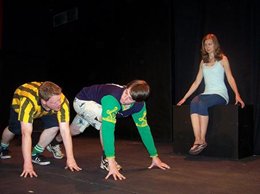Set in Kilkenny and Sydney in the year 2000, Bondi Beach Boy Blue dramatises the story of Declan, a talented young hurler, whose dream of making the senior county panel is ended by a crippling knee injury.
Declan is 17 and about to leave school; his mother has died four years previously and his relationship with his father is strained. Following his injury and a break-up with his girlfriend Lisa, he and best friend Gary escape boredom and frustration by heading off to Australia. There they meet up with Emma who persuades them to take part in the 14km 'City to Surf' road race from Sydney to Bondi Beach. By being economical with the truth to Declan’s uncle Donie, a reporter for the Kilkenny People, the boys become local heroes back home as 'race winners' and Ireland’s candidates for the Sydney Olympics long-distance track event. However, things are complicated as Declan’s father has suffered an accident on the farm and is in a critical condition in hospital. The play ends as Declan is faced with the dilemma over whether to keep up the pretence or tell the truth and risk his father’s recovery.
While there are moments of charm, humour and insight in Bondi Beach Boy Blue, such as the build up to the big match or the night of the local disco, overall the play suffers from a lack of financial investment in production elements such as set, costume and sound design and, given that the play has received previous productions, a lack of critical reflection on the script, casting and directing.
 One suspects that too much is expected of too few within the production team with Donal Courtney bearing the brunt of the workload taking the roles of director, co-producer, set designer and costume manager, and the lack of dedicated expertise is obvious in production. The set consists of two small black cubes on a black floor against black drapes while the rather sparse soundtrack provides inconsequential musical links between scenes, adding neither atmosphere nor pace to the drama. Eoin McNinch’s lighting design is functional rather than atmospheric, using a general yellow wash in the main with occasional boxes of yellow light to isolate the actors when they are alone in a scene but not on the stage. There are ample opportunities for creativity in design but these are not realised, much to the detriment of the production which appears shabby and under dressed.
One suspects that too much is expected of too few within the production team with Donal Courtney bearing the brunt of the workload taking the roles of director, co-producer, set designer and costume manager, and the lack of dedicated expertise is obvious in production. The set consists of two small black cubes on a black floor against black drapes while the rather sparse soundtrack provides inconsequential musical links between scenes, adding neither atmosphere nor pace to the drama. Eoin McNinch’s lighting design is functional rather than atmospheric, using a general yellow wash in the main with occasional boxes of yellow light to isolate the actors when they are alone in a scene but not on the stage. There are ample opportunities for creativity in design but these are not realised, much to the detriment of the production which appears shabby and under dressed.
While the production is undermined by a lack of effective sound, lights and costume, most crucially it also fails to convey the sense of speed, agility and nervous energy associated with the game of hurling. This is most obvious in a montage of still images where Connaughton and Gallagher pose mid-shot, mid-game. The pace is slow, the transition between the images is awkward and the images shown are pedestrian. As such the sequence fails to capture the speed, skill, and physicality that characterises the game.
While the cast work well together, with Martin Maguire particularly engaging as Declan’s father and his uncle Donie, the casting of Paul Connaughton as Declan is less successful. Though an enthusiastic performer, his performance is characterised by a comic lethargy rather than physical athleticism. Since the destruction of his dream to play for Kilkenny is the critical incident providing momentum to the narrative, the fact that he is not credible as an athlete undermines every other aspect of the story which becomes less and less convincing as the drama unfolds.
Essentially Benny McDonnell’s script is overly ambitious: there are too many story lines which prove impossible to integrate and explore. The script relies heavily on direct address to the audience to provide narrative exposition, usually at the expense of dialogue and action. The audience is informed of everything that the characters think and feel and little of this finds physical expression. The result is that the play is a drama based on events, and the fact that these events then find no resolution makes the production rather anticlimactic and disappointing.
Dr Úna Kealy is a lecturer in the Department of Creative & Performing Arts, Waterford Institute of Technology.